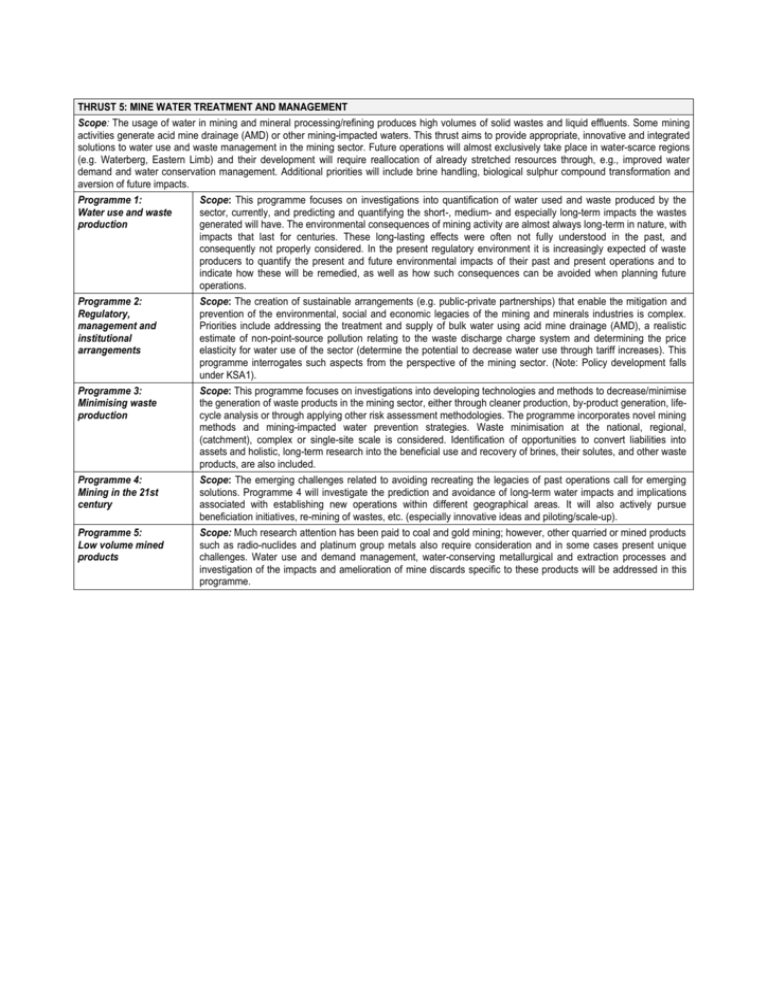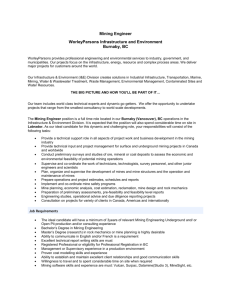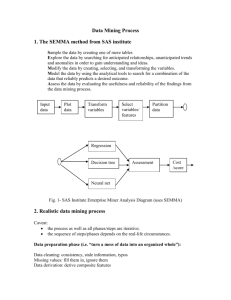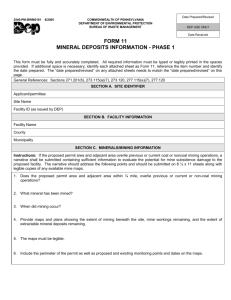KSA 3THRUST 5 - Water Research Commission
advertisement

THRUST 5: MINE WATER TREATMENT AND MANAGEMENT Scope: The usage of water in mining and mineral processing/refining produces high volumes of solid wastes and liquid effluents. Some mining activities generate acid mine drainage (AMD) or other mining-impacted waters. This thrust aims to provide appropriate, innovative and integrated solutions to water use and waste management in the mining sector. Future operations will almost exclusively take place in water-scarce regions (e.g. Waterberg, Eastern Limb) and their development will require reallocation of already stretched resources through, e.g., improved water demand and water conservation management. Additional priorities will include brine handling, biological sulphur compound transformation and aversion of future impacts. Programme 1: Water use and waste production Scope: This programme focuses on investigations into quantification of water used and waste produced by the sector, currently, and predicting and quantifying the short-, medium- and especially long-term impacts the wastes generated will have. The environmental consequences of mining activity are almost always long-term in nature, with impacts that last for centuries. These long-lasting effects were often not fully understood in the past, and consequently not properly considered. In the present regulatory environment it is increasingly expected of waste producers to quantify the present and future environmental impacts of their past and present operations and to indicate how these will be remedied, as well as how such consequences can be avoided when planning future operations. Programme 2: Regulatory, management and institutional arrangements Scope: The creation of sustainable arrangements (e.g. public-private partnerships) that enable the mitigation and prevention of the environmental, social and economic legacies of the mining and minerals industries is complex. Priorities include addressing the treatment and supply of bulk water using acid mine drainage (AMD), a realistic estimate of non-point-source pollution relating to the waste discharge charge system and determining the price elasticity for water use of the sector (determine the potential to decrease water use through tariff increases). This programme interrogates such aspects from the perspective of the mining sector. (Note: Policy development falls under KSA1). Programme 3: Minimising waste production Scope: This programme focuses on investigations into developing technologies and methods to decrease/minimise the generation of waste products in the mining sector, either through cleaner production, by-product generation, lifecycle analysis or through applying other risk assessment methodologies. The programme incorporates novel mining methods and mining-impacted water prevention strategies. Waste minimisation at the national, regional, (catchment), complex or single-site scale is considered. Identification of opportunities to convert liabilities into assets and holistic, long-term research into the beneficial use and recovery of brines, their solutes, and other waste products, are also included. Programme 4: Mining in the 21st century Scope: The emerging challenges related to avoiding recreating the legacies of past operations call for emerging solutions. Programme 4 will investigate the prediction and avoidance of long-term water impacts and implications associated with establishing new operations within different geographical areas. It will also actively pursue beneficiation initiatives, re-mining of wastes, etc. (especially innovative ideas and piloting/scale-up). Programme 5: Low volume mined products Scope: Much research attention has been paid to coal and gold mining; however, other quarried or mined products such as radio-nuclides and platinum group metals also require consideration and in some cases present unique challenges. Water use and demand management, water-conserving metallurgical and extraction processes and investigation of the impacts and amelioration of mine discards specific to these products will be addressed in this programme.











